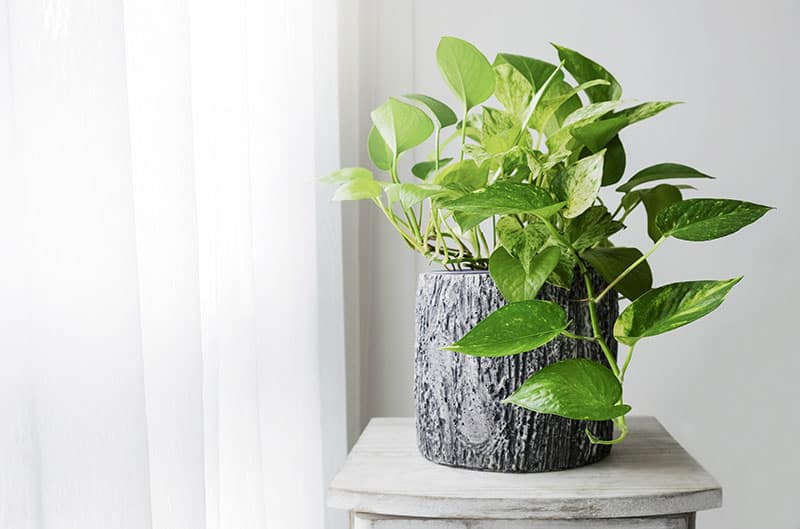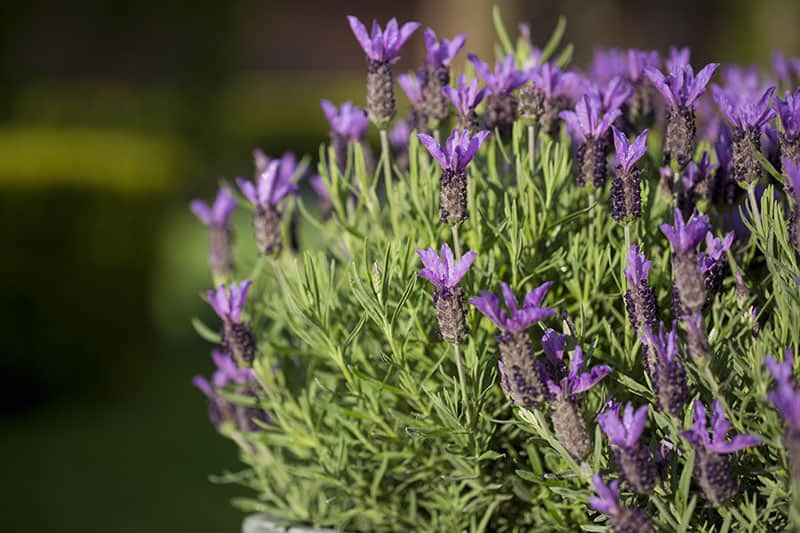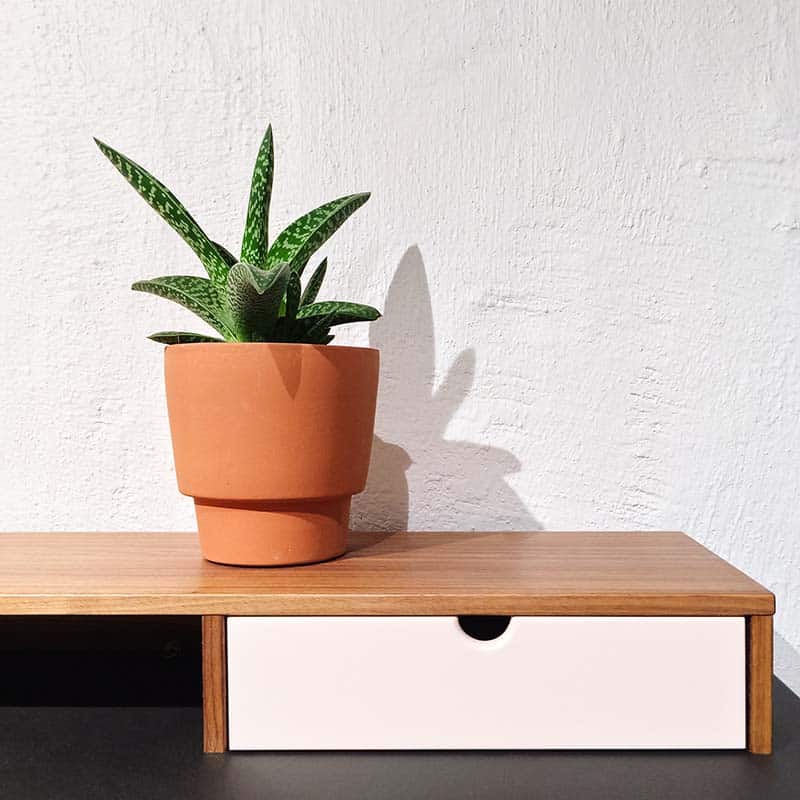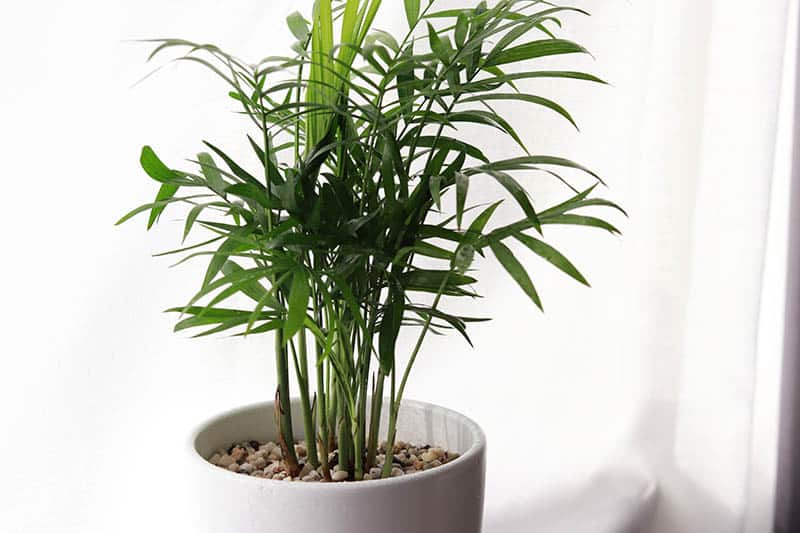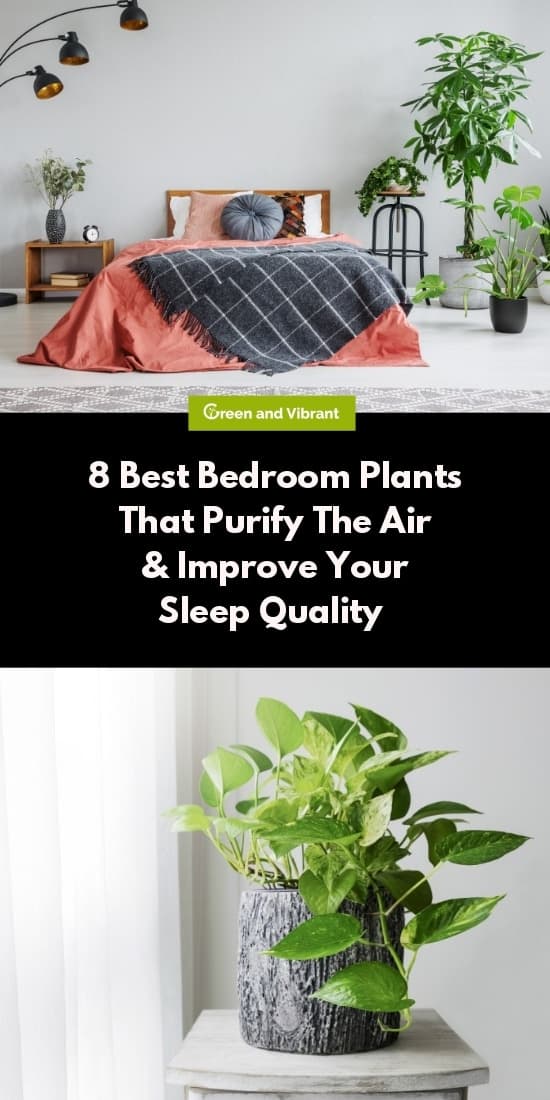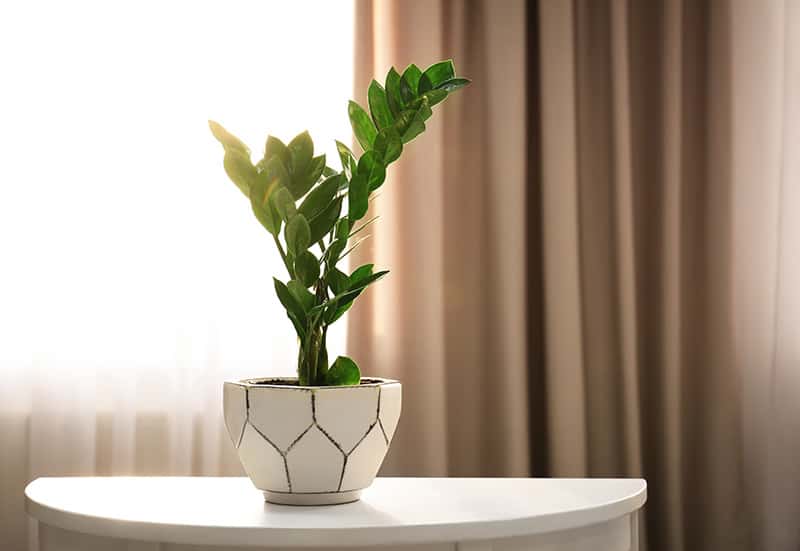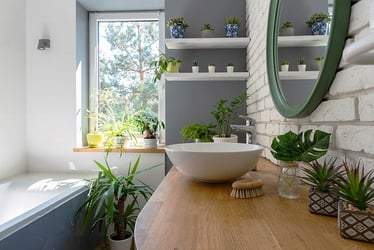Ah, a treehouse. Is there anything that symbolizes the joy, freedom, and m... Read More
- Home >
- 8 Best Bedroom Plants That Purify The Air & Improve Your Sleep Quality
8 Best Bedroom Plants That Purify The Air & Improve Your Sleep Quality
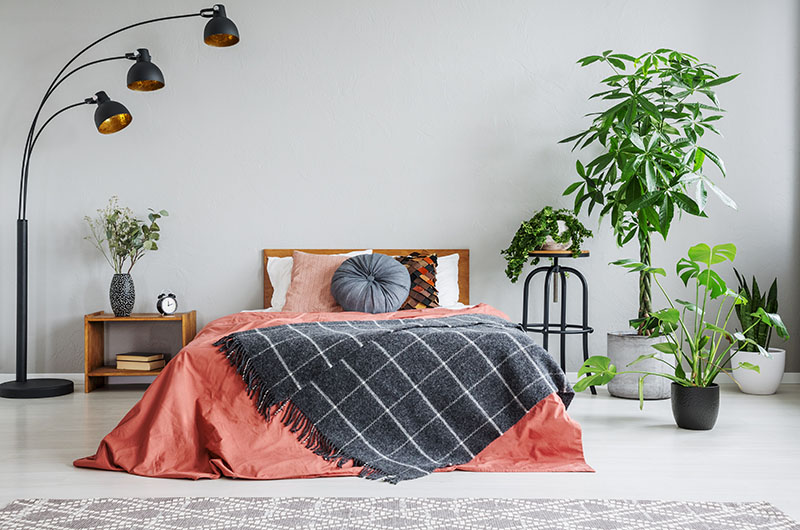
If you’ve been thinking of adding some plants to your sleeping quarters, then you may be interested to know that some plants are better than others in the bedroom. It was proven by NASA in 1989 that plants can remove toxins from our air, but not all plants were created equal when it comes to their air filtering and sleep-inducing abilities. This article contains the ultimate list of the best houseplants to grow in your bedroom if you want to increase your chances of a better night’s sleep.
Benefits of Plants in Bedrooms
Increased Humidity
Some plants can increase the humidity of our air by a process called transpiration. They absorb water from the soil with their roots, and then, circulate that water throughout their stems and leaves with a vein-like system. Once the water gets to the leaves, some of it evaporates and therefore increases the humidity of the air around it.
Some plants are much better at this than others. For example, the Areca Palm has one of the highest transpiration rates of any plant, with a six-foot plant being able to evaporate a quart of water into the air in every 24-hour period. Higher humidity is especially beneficial in the bedroom as for most people it is where they spend a large portion, if not the highest proportion, of their time, and high humidity has numerous health advantages.
Higher humidity can work wonders on the condition of your skin, and having a humidifier at home has long been recommended by dermatologists for this very reason. While dry air can leave your skin and lips feeling dull and chapped, moist air has the opposite effect. If you sleep in high humidity, you can expect to wake with your skin feeling more supple and refreshed. High humidity isn’t just good for you in cosmetic terms, and it can also help prevent colds and flu.
A research has shown that at below or equal 23% of relative humidity, total virus collected stayed at 70.6–77.3% infectivity but increased humidity (above 43%), only render 14.6–22.2%. This could go a long way to preventing infection and keep you in tip-top health. If you are unfortunate enough to contract a cold or virus, high humidity could help you out. Increased moisture in the air will help to relieve the pain in your nasal passages, making it easier to breathe. For this reason, high humidity is also recommended for a range of respiratory conditions.
Air Purification
A NASA study in 1989 found that houseplants can work to remove common toxins from the air. Formaldehyde, benzene, xylene, and trichloroethylene, among others, are dangerous carcinogenics, causing volatile organic compounds, which are released into our air through a number of ways. Some of the common items in homes which release these chemicals are carpets, laminate flooring, paint, household detergents, glues, pesticides, and smoking.
Since homes have become better insulated in an effort to improve energy efficiency, this has actually worsened the problem of toxins in homes. With less air circulation, toxins in the air in our homes has become trapped, causing levels of toxins to rise. Because we can’t see these toxins, it is typically something we don’t think about, let alone try to rectify. However, it has been shown that sustained exposure to even low levels of these chemicals can cause minor health problems, such as headaches, to more worrying issues, including types of cancer.
Toxins in the air in your home can also irritate ears, nose, throat, and skin, and cause increased problems for sufferers of asthma. Allergies have also been known to be worsened, and even caused, by air pollution within homes. One of the ways we can combat this is with houseplants, which have been proven to filter toxins from the air. Studies have revealed that some plants can remove over 80% of toxins in the air in as little as 24 hours, resulting in a much healthier air for you and your family to breathe. NASA recommends having between 15 and 18 air-filtering house plants in an 1800-square-foot home.
Soothing Properties
Some scented plants have the ability to soothe and relax your mind, making it easier to fall asleep and improving the actual quality of your sleep. Breathing in the aroma of one specific plant has the effect of slowing your heart rate and relaxing your muscles, leading to a well-rested night’s sleep and a higher level of energy the following day. Another plant has been shown in studies to have a similar sedative effect of taking valium pills.
Stress Reduction
Houseplants are known to reduce stress, anxiety, and depression. For this reason, it would be particularly effective to keep houseplants in your bedroom, as a reduction in stress and anxiety will be key to a more restful night of sleep.
Stylish Décor
Anyone who checks out Pinterest or Instagram will have noticed that houseplants are massively on trend right now. They are experiencing a resurgence in popularity in all kinds of interior design styles, from contemporary, modern, to country chic. Adding a houseplant to your bedroom will instantly update your look and give your decor a lift. It can play a big part in your bedroom color scheme. Architectural-looking plants can have a particularly strong visual impact. As well as being fashionable, houseplants also help to breathe life into your interior design, making a dull or drab room feel fresh, vibrant, and renewed.
Overnight Oxygen Release
All plants take in carbon dioxide and release oxygen during the day; however, this process is typically reliant upon the presence of light, so the majority of plants work in reverse in the absence of light during the night, taking in oxygen and releasing carbon dioxide. However, some plants operate differently and are actually able to continue respiration with no access to light. These plants continue to release oxygen throughout the night, making them ideal bedside companions. It is alleged that an increase in oxygen during the night will help you to breathe better, and the air you are breathing will be healthier. Both of these things can aid with sleep.
The Best Plants to Grow in Your Bedroom
1. Golden Pothos (Epipremnum aureum)
Also known as Devil’s Ivy, this easy-care plant can be grown by even those with a track record of killing plants, as the Golden Pothos has a reputation for being almost indestructible. It will grow in any lighting position from bright light to full shade and is very tolerant of infrequent waterings.
Like many houseplants, in spite of the Golden Pothos being forgiving of most conditions, one thing it will not be able to cope with is overwatering. Sitting in soggy soil will eventually lead to root rot, whereby the plant’s roots become so damaged that they are unable to deliver moisture and nutrients to the rest of the plant, and it starves to death. Avoiding this scenario is easy, by simply checking the soil to make sure it is dry before you proceed to water it.
Aside from being a breeze to grow and care for, this plant is beneficial to have in the bedroom because of its air-purifying qualities. It is rated by NASA as being one of the top 10 air-filtering houseplants, able to effectively remove chemicals such as formaldehyde and benzene from indoor air. It is also a very attractive plant, with a trailing habit that looks good draping down from a high shelf or windowsill. You can prune the plant back when its stems become too long. It also responds well to pruning, so inexperienced growers do not need to be worried about causing damage during pruning.
2. Peace Lily (Spathiphyllum)
This pretty plant is a good choice for anyone who likes to have some flowers among their foliage, as the Peace Lily features an array of brilliant white flowers, which in technical terms are actually not flowers but, in fact, a special type of leaf called a hooded bract. In spite of its name, the Peace Lily is not really a lily at all, and instead is a member of the Araceae family, though its flowers do bear a strong resemblance to those of the Calla Lily.
It is the perfect plant to grow in a bedroom because it is able to improve the quality of indoor air by up to 60%. It is especially good at absorbing mold, preventing mold and mildew from forming on window frames or any area in your bedroom that is susceptible to damp conditions.
The other great thing about the Peace Lily is that it is very tolerant of low light, so it can brighten up a dull corner of your bedroom which doesn’t receive much natural light. If you want to increase flower production, this plant will need to come out from the shade and receive a few hours of bright, indirect light each day, but if you are not especially fussed about having a mass of flowers on your Peace Lily, then you can leave it in a shaded area all year long. The foliage of this plant is actually very attractive, so many people do grow it just for the look of its lush bright green leaves.
It is a very low-maintenance plant that does not require much care or attention. It can be watered infrequently, as it is drought-tolerant, so it can withstand reasonable lengths of time without water. The Peace Lily is a plant that would prefer to be underwatered than overwatered, as it does not like to be sitting in soggy soil, and, in fact, overwatering is one of the most common ways to kill this plant.
To keep it healthy, only water once the soil is dry to the touch. The Peace Lily is actually very good at letting you know when it wants to be watered, as its leaves will become limp. When this happens, you should give it a generous watering, and it will perk right back up. Then, refrain from watering until its foliage starts to droop again.
A word of warning to pet owners: this plant is toxic to cats and so should be avoided if your pets are likely to nibble on any part of the plant.
3. English Ivy (Hedera helix)
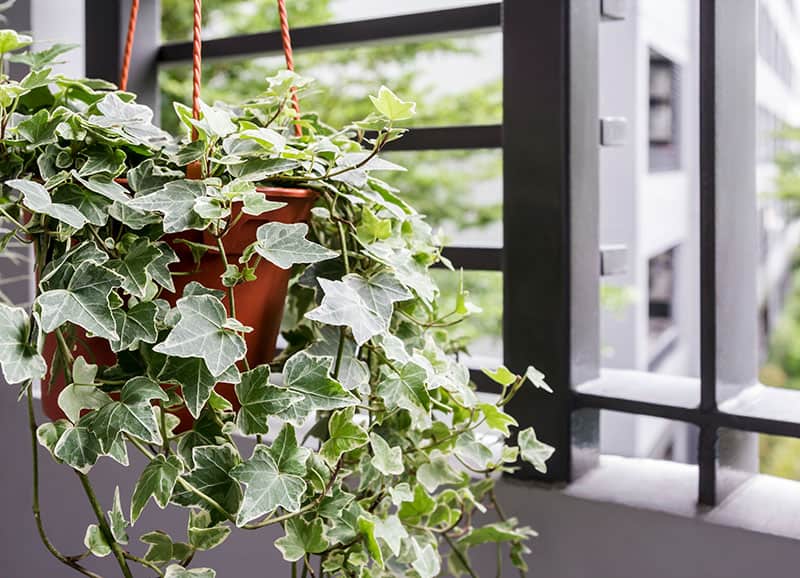
English Ivy is one of the best houseplants for its ability to effectively filter a wide range of toxins from the air. A NASA study found that it was able to filter five of the most commonly found indoor air pollutants: formaldehyde, xylene, benzene, ammonia, and trichloroethane.
Some studies have also shown that it efficiently removes airborne mold particles, which is vital for maintaining good health. Exposure to mold has been known to cause throat, skin, nose, and eye irritation, and can also cause wheezing as well as skin complaints. Keeping Ivy in your bedroom is a brilliant natural way to combat mold, and its presence will work to prevent you from breathing in harmful mold particles while you sleep.
This plant also works well in a bedroom because it is easy to grow and is very low-maintenance, making it ideal for amateur plant growers or anyone who is too busy to be caring for plants. The English Ivy is usually seen climbing up fences and exterior walls, and many people are often surprised to find that it actually makes a very good houseplant. It will grow in almost any level of light and doesn’t need to be watered too often. It can grow quickly, so you may need to prune it occasionally to prevent it from growing out of control, but this can easily be done with a sharp pair of scissors and does not require any special skills or knowledge.
Ivy looks stunning when allowed to drape down from a plant pot kept on a high shelf, or when trailing from a hanging plant pot. Ivy also has the advantage of being inexpensive to buy, so in the unlikely event that you do manage to kill your Ivy, you won’t be out of pocket. Ivy is unbothered by soil type, humidity levels, temperature, and light. As long as you are happy with the temperature of your home, then the Ivy will be happy.
Water the plant once the soil has dried out; this is a good method to prevent overwatering. Overwatering is the most common way to kill this plant, so err on the side of caution and only water when the plant needs it.
4. Aloe Vera
Aloe Vera is one of the top air-filtering plants, able to rid the air from benzene, which is a harmful toxin commonly found in household cleaning products and paint. If you are sleeping in a room that has recently been redecorated, and you are concerned about the chemicals that the fresh layers of paint are giving off, then Aloe Vera would be the best plant to introduce into the room.
As well as purifying the air from toxins, Aloe Vera is one of the few plants that continue respiration throughout the night. This means that while you are sleeping, the plant is working to take in carbon dioxide from the air and give out oxygen. This provides you with ultra-fresh air to breathe while you are sleeping, which is good for your health and will potentially result in a better night of sleep.
Added to these already fantastic benefits of Aloe Vera is the fact that it is a handy plant to have around for its healing properties. The gel contained within the stems is considered to be almost a miracle cure for burns and cuts; simply snap off a stalk and use the gel from inside it to rub directly onto your injury for instant natural relief.
This plant is also incredibly easy to care for. As a succulent, it appreciates bright light and minimal waterings. Set it on a windowsill or bright side table and then, forget about it, watering it every few weeks. The plant is drought-tolerant and will respond to underwatering much better than overwatering. Always test that the soil of an Aloe Vera plant is dry before watering it to prevent the problems associated with overwatering, such as root rot.
5. Lavender (Lavandula)
This herb has been used throughout history as a natural medicine for a number of ailments. The flowers of the plant are used to create an essential oil, lavender oil, which is said to be antibacterial, antifungal, and effective in treating hair loss, skin wounds, anxiety, depression, and fungal infections, among other things.
Lavender has also long been known for its sleep-inducing properties, and many sleep aids in the form of sprays, balms, oils, and lotions can be purchased commercially with lavender among the key ingredients. If you are having trouble getting to sleep or staying asleep, then lavender is an ideal plant to grow in your bedroom.
Though it is typically thought of as an outdoor plant, Lavender actually makes a very good houseplant providing the conditions are right. Lavender likes lots of sunlight, so a position in a window would be ideal. It also likes a fair amount of water, so well-draining soil is key to prevent the soil from becoming waterlogged and damaging the plant’s root system.
There are many varieties of Lavender plant, with some being more aromatic than others. To fill your room with the heady scent and help to induce sleep, choose a heavily fragrant variety such as English Lavender (Lavandula angustifolia) or Lavandin (Lavandula x intermedia). Studies have shown that the aroma of Lavender may be able to alter brain waves and reduce stress. Subjects in studies of Lavender have experienced a greater level of relaxation and more energy. Some studies have also indicated that Lavender is able to relax muscles and slow the heart rate, resulting in subjects falling asleep more easily and achieving a deeper level of sleep. Other studies have shown that Lavender can help reduce anxiety and depression among postpartum mothers, which is also likely to lead to better sleep.
Of all herbs and associated essential oils, Lavender is among the most studied, and the results indicate that the alleged positive effects of Lavender are much more likely to be true than lesser studied herbs. If you suffer from insomnia, or any sleep-related conditions, growing this plant in your bedroom is a good natural method to try to help improve your sleep. Take in a few deep breaths of Lavender each night before you get into bed, and let the magic happen. Even if you find that the Lavender doesn’t improve your sleep, at least you will have a beautiful flowering herb decorating your bedroom and a wonderful aroma to welcome you into the room.
6. Snake Plant (Sansevieria)
This easy-care plant is a perfect addition to bedrooms; it filters toxins from the air and converts carbon dioxide to oxygen throughout the night. Rated among the top 10 air-filtering plants by NASA, the Snake Plant effectively cleans indoor air and removes harmful chemicals such as xylene and toluene. It also increases the oxygen content of your air while you sleep, aiding in better sleep and better overall health.
As a succulent, this plant is drought-tolerant and can cope just fine if you occasionally forget to water it. In fact, it would prefer if you ignored it quite regularly, as overwatering is the biggest reason for the death of this plant. Ensure the soil is allowed to dry out between waterings by dipping your finger into the soil to check for moisture. If the soil is moist, you should wait another day or two before checking again to see if the plant needs to be watered. Only water once the top few inches of the soil feels dry. This plant also likes to receive a fair amount of bright, indirect sunlight.
7. Areca Palm (Dypsis lutescens)
With multiple potential health benefits, a tropical appeal, and an easy-care nature, the Areca Palm really has it all. This plant is rated as one of the best by NASA at removing indoor air pollutants, which will improve air quality in your bedroom and lower your chances of becoming ill while also encouraging better sleep.
The Areca Palm is also among the top rated plants at increasing humidity, which is great for anyone suffering from colds or sinus problems as it eases the side effects of these conditions, allowing for a better night’s sleep. Higher humidity also kills a high percentage of airborne bacteria and viruses, preventing you from getting sick.
This plant is also one of the few to release oxygen overnight, providing you with clean, fresh air while you sleep. The Areca Palm is quite a large plant and will require space on your floor several feet wide to allow the fronds to fan out. Other than its space requirements, the Areca Palm is incredibly low-maintenance and easy to care for. It likes to be in a position of bright, indirect light, and as long as it gets this, it will be quite forgiving of other conditions. Keep its soil moist during warmer months but allow the soil to dry out between waterings during fall and winter.
8. Gardenia (Gardenia jamsinoides)
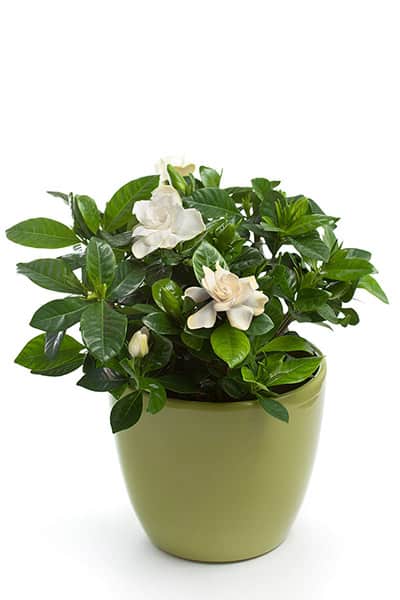
The Gardenia plant, also referred to as the Cape Jasmine, is effective in inducing deep sleep, and so is ideal for growing in the bedroom if you have trouble drifting off or are a victim of restless nights. A study conducted in Germany showed the effects of this plant to be as effective as Valium medication in reducing anxiety and helping with sleep problems, so it is certainly worth trying if you struggle with these issues.
Growing Gardenia in your bedroom is an entirely natural way to help with your sleep or anxiety problems and therefore is much better for you than taking Valium pills or other sleeping tablets. It removes the risk of side effects from taking medication and will also lower your medical bills!
Inhaling the scent of Gardenia is all you need to do to benefit from its sleep-inducing abilities, so simply grow it in your bedroom, ideally on your bedside table sothat you can continue to breathe in the plant’s aromas while you sleep.
The major setback with keeping Gardenia is that it is quite a tricky houseplant to keep alive. It is very specific in its requirements and will not tolerate neglect or inappropriate conditions. It will need a bright spot, ideally with at least half a day of direct sunlight. This plant also requires fairly cool temperatures, within a precise range of 55 and 65º F.
It also needs high humidity, which can be achieved indoors in a variety of ways: placing plants in groups will increase humidity as they can benefit from each other’s transpiration process. You could also use an electric humidifier in particularly dry seasons, or lightly spray the plant each day with a water mist. Another option is to sit the Gardenia on a pebble tray, where a tray of pebbles is covered in water. As the water evaporates from the pebbles, the air around the plant will be filled with moisture. If you do take this route to increase humidity, make sure that the water does not reach a higher level than the top of the pebbles; otherwise, the water could be absorbed through the drainage holes on the underside of your plant’s pot, and your Gardenia could end up being overwatered.
Sources:
Related Content
-
13 Simple Treehouse Ideas You Can Build For Your Kids This Weekend (Easy to Expert Levels)
-
Guide to Hydrogen Peroxide (H2O2) in Hydroponics
If you want to boost the productivity of your crops, chemistry is your bes... Read More
-
23 Cheap & Amazing Garden Edging Ideas You Can Try
Stuck for inspiration on ways to tidy up the perimeter of your garden? A n... Read More
-
All about Spider Mites and How to Get Rid of Them
Home growers and gardeners tend to be quick to learn one of the most uncom... Read More
